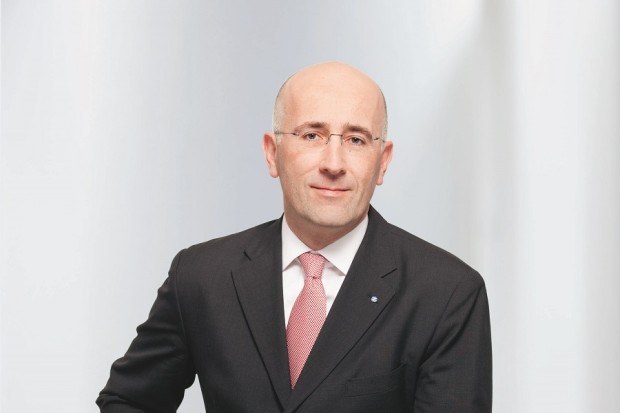Change is underway to reshape some ailing General Insurance business at Zurich Insurance Group, according to the new chief executive for the unit, who described a corrective focus on profitability over growth during an analyst conference call last week.
Executive Summary
Kristof Terryn, CEO of Zurich General Insurance, explained that underappreciated trends in large losses and a focus on growth over profitability were among contributors to a decline in operating profit this year, as he outlined actions including reunderwriting, reinsurance purchasing and job cuts to get the business back on track during an earnings conference call.But while part of the plan to get business back on track involves exiting underperforming portfolios, “this is not about shrinking to success,” said Kristof Terryn, the former CEO of Zurich’s Global Life unit, who officially took the reins of General Insurance (GI) on Oct. 1. Terryn instead described a tier-by-tier analysis for the property/casualty business that also involves activities like reunderwriting, reassessing the use of reinsurance and retentions, as well as reshaping the management team.
“We are taking a targeted and differentiated approach and we will continue to invest in those areas where we are getting traction and delivering top line [growth] at the [return] hurdles we expect, Terryn said, contrasting Swiss business and areas of North American Commercial (NAC) business that are performing well against U.S. trucking business and a standalone boiler and machinery line, which are on the chopping block.
Terryn highlighted unrecognized trends in large losses and risk interconnectivity, and a focus on growth over profit as the culprits denting financial results for the third quarter—and in the first half of 2015. He also revealed something that will be shrinking—the size of the workforce by 200 positions—during a Nov. 5 earnings conference.
Terryn joined Zurich Group CEO Martin Senn and Chief Financial Officer George Quinn on the call to lay out their diagnoses of the contributors to 79 percent drops in both third-quarter operating profit and net income for the entire group, along with steps being taken to repair the damage largely caused by the GI business.
The GI third-quarter operating loss of $183 million reported on Nov. 5 was in line with a $200 million estimated loss that Zurich signaled in an earnings warning published on Sept. 21, just weeks after Zurich also announced that Terryn, a former McKinsey consultant, would be moving from the life to the P/C side of the company. The late September announcement also disclosed a $275 million loss related to the explosions in Tianjin and a needed boost loss reserves for prior years.
“I am absolutely convinced that we have the actions in place to start rebuilding the credibility of our GI business with investors,” said Senn, turning the call over to Terryn to provide details of the outcome of an initial review of the business by the new GI leader and to Quinn to discuss the reserving actions.
Governance, Job Cuts and Large Losses
- Financial base-lining and ambition setting
- Technical excellence
- Expense reduction
- Strategy and portfolio focus
- Organization and governance
Terryn said his third-quarter review builds on actions that were already underway at the half year. “This review focused on five elements [ranging] from understanding the financial strength of the business all the way to governance,” he said, indicating that the two most important elements of focus are “an improvement of our underwriting performance and an accelerated drive toward greater efficiency.” (The final area is the re-evaluation of key strategic priorities for each country.)
An analyst, however, wanted to know more about the “organization and governance” aspect of the review. “What was the weakness identified in organization and governance, and how do you think you solved it,” he asked.
Terryn’s response shed light on the 200 job cuts.
“We looked at the overall setup and as part of that, we actually are driving a reduction of the number of people we have sitting in the global layer….The basic principle is that you want to put accountability back in the front line within the market, and I actually don’t believe that the size of the organization that we had on top is commensurate with what needed to be done,” he said. (Zurich announced some 800 job cuts in March 2014 with a similar intent.)
He continued noting that the “control environment” is being strengthened in spite of any workforce reductions. “I think in some areas we have just pushed growth over profitability. That’s an area where we need to intervene,” he said, suggesting that inappropriate “strategic steering” was at the heart of the unfavorable performance. “Actually making things simpler at the top—[or] smaller—[means] we’ll be much more focused on a holistic picture of what needs to be done, and understand the tradeoffs that need to be made between growth and profitability,” he said.
Terryn said a lagged response to large losses was another red flag in his review. “We have been somewhat slow in recognizing what was a trend and not a one-off. That is an area where we’ve done a deeper dive,” he said. “We’ve made some of the points about reducing our exposure, being careful about where we actually allocate capital, taking a look at what retentions we are willing to take on standalone risks and also the relationship…These are all things we are looking at.”
Pointing to Zurich’s $275 million loss related to the Tianjin explosion, another analyst pressed Terryn further on large losses, noting that Zurich had told investors that underwriters would be careful to avoid risk concentrations way back in 2003 in the wake of concentrated property losses from the World Trade Center attacks.
“Where we have been particularly strong is when it comes to managing the aggregation of our property portfolio,” Terryn responded. “I think the interplay of business interruption, property risks, cargo etc. is where I want to do a deeper dive and understand whether we have the right accumulation management across all the different lines of business in place.”
While Terryn also noted that Zurich’s disproportionate share of the Tianjin loss was not entirely unexpected given that the insurer is one of the biggest players in the impacted OEM (original equipment manufacturer) space, he said there is still work to do to make sure Zurich aligns risks and rewards on business with large loss potential. “We’re not seeing the right returns on the large loss exposures that we’re writing,” he said. “The strategic review looking at accumulations of retentions, reductions of lines and the use of reinsurance, I think is the right answer to that issue.”
Quinn talked about risk-reward tradeoffs of the different sort at one point during the call. “Just to avoid that I give the signal to our reinsurance partners that we’re willing to buy reinsurance at any price, we’re evaluating the risks,” the CFO said.
Tier by Tier
During Terryn’s prepared remarks on planned underwriting actions, the GI CEO stressed that the toughest of these actions will be confined to underperforming books of business.
Some of the underperforming books specifically identified on the slide are: auto liability in NAC; auto liability in Global Corporate in North America (which write larger accounts than NAC); NAC construction liability; property and liability in Global Corporate. “For these portfolios, we put in place some very concrete actions for underwriting improvements with detailed weekly tracking leading up to the Jan. 1 renewals,” Terryn said.
While Zurich will be exiting some U.S trucking business, standalone Global Corporate boiler and machinery and other portfolios where turnaround aspirations seem clearly unrealistic, he stressed that the go-forward strategy “is not just about exiting underperforming portfolios. It is about focusing our efforts and taking tough underwriting actions where it makes sense while considering achievability and the long-term customer relationships.”
“Within the overall targeted portfolios, we will be focusing on achieving rate and/or lift, recognizing that in some markets and lines of business rates are still softening. This is where tiering will be a key lever with particular focus on finding a better balance better risk levels and pricing.
“For some of the bottom tiers of our underperforming portfolios, this will mean some very significant rate increases often at the expense of a significant drop in retention levels,” he said.
Still Terryn and the other executives suggested that there will only be “a modest decline” on Zurich’s top line next year—a prediction that puzzled one analyst whose mental math suggested that premium would have to shrink much more to limit the damage of those 15 books with the 140 third-quarter combined ratio, and to pull a 101.9 combined ratio overall (for the first nine months) anywhere near a stated goal 96.5-97.5 in 2016.

“A lot of the improvement we are likely to see from lift, which is really a shift in the profitability of the portfolio through the tiering exercise because it is unlikely you’ll see a big change in what the market will tolerate in terms of rate increases going into 2016,” Terryn said.
“We will have a very differentiated approach [and] even within some of the portfolios that are underperforming, we are very differentiated,” Terryn explained. “We look at lines of business as part of an overall client relationship, and from a distributor angle as well. We will take very different actions on the bottom tiers of those portfolios than we will on those that are actually performing.”
Another analyst worried that Zurich might not be taking enough action on better-performing books, reasoning that their average combined ratio of 94 wasn’t particularly enviable in a low-catastrophe year.
“Across the book, margin is the top priority over volume,” Terryn assured. “That does not mean that some parts of the book will not continue to grow because we see continued good profitability in some parts. But as far as the rest of GI—that $17.7 billion—that will see some shrinkage and require some rate as well,” he said.
Reserving Prudence
Still another analyst worried specifically about the commercial auto book, referring to an indication in some of the financial exhibits that only a 4 percent commercial auto rate hike is in the works.
Taking a cue for Terryn’s remarks, Quinn reassured that the sub-segments of the commercial auto market where Zurich sees the most significant negative loss cost trends are going to be very high on the list of priorities for targeted actions. “We have a particular exposure on some of the larger trucking end of market….That’s an area that we’re going to tackle with vigor before the end of next year,” Quinn said.
Quinn also described prudence in tackling the review of loss reserve adequacy. He noted that that while the Sept. 21 earnings warning signaled a charge for commercial auto, when the books for the quarter were actually closed, Zurich also took up prior-year reserves for “one specific sub-portfolio of the construction liability business in the U.S.”
The September warning of a potential $200 million third-quarter operating loss for GI overall also incorporated an estimate of normal natural catastrophe losses, Quinn noted, reporting that actual natural catastrophe losses came in much lower than anticipated.
“These two items offset each other,” he said, noting that the additional reserve strengthening and the lower cat losses left Zurich in roughly the same place as result as the September announcement had indicated.
“I am well aware that that second [reserve action] will further fuel a debate about the overall reserve position. Of the choices, this seemed to me to be the best one,” the CFO said, going on to stress three points about Zurich’s reserves:
- Most other portfolios are showing expected modest releases.
- “We believe we are prudently reserved, and our reserves are set above the midpoint of the range.”
- “We believe the reserving process is robust with multiple levels of internal and external reviews with a generally consistent view of overall reserve strength.”
“Obviously, we need to demonstrate a more consistent track record in the coming quarters and to actually deliver a PYD [prior-year development] within the 1-2 percent range,” Quinn added.
“No one can predict how our reserves will evolve perfectly, but with the actions taken in Q3, I believe we’re in a stronger position and with lower levels of expected volatility,” Quinn said.
Quinn made a similar statement about the individual construction liability sub-segment involved in the latest reserve action.

“We’re a market leader in this relatively small segment,” he said. “The claims are quite lumpy so they tend to be quite large in nature,” he said, noting that the construction sub-segment isn’t particularly large in terms of premium volume, coming in at roughly $200 million. “So it does pose some reserving challenges but given what we’ve done we think it’s at an appropriate level of reserves for this line of business.”
Quinn joined Terryn in addressing questions beyond those related to loss reserves and excess capital deployment, in particular, responding to concerns about the speed with which Zurich can return the GI book to profitability.
When you look at Zurich’s assessment of where it needs to improve, “the largest single theme is actually large loss,” Quinn said, noting that much of the large loss is attributable to short-tail lines. “Even though commercial auto stands out as one of the major challenges— it is a longer-tail line, which means it takes longer to effect the change,” he said noting that commercial auto actions are not going to be the key source of the overall underwriting improvement.





















 Howden US Tells Judge Brown & Brown Employees Fled Due to ‘Mistreatment’
Howden US Tells Judge Brown & Brown Employees Fled Due to ‘Mistreatment’  Heating Fuel Haulers Temporarily Exempt From Drive Time Limits
Heating Fuel Haulers Temporarily Exempt From Drive Time Limits  Northern California Flooding This Weekend Caused by Heavy Rain, High Tides
Northern California Flooding This Weekend Caused by Heavy Rain, High Tides  California Workers Comp Combined Ratio for 2024 Highest in 20-Plus Years
California Workers Comp Combined Ratio for 2024 Highest in 20-Plus Years 













